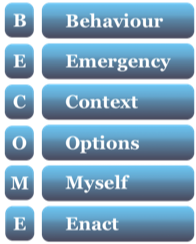Your are at:
- > Home
- > Free stuff
- > BECOME steps
Why do you need six steps to encourage appropriate behaviour?
Everyone likes to focus on solutions to problems and so do we. But when you have 20 odd solutions to choose from how do you know which is the best one? That is why we have six steps, to help work out and narrow down the strategies that bring about the solutions. Coming up with the best response is not difficult in most cases, but when it is difficult you need all the steps to solve it. The six steps help to:
- pin point what the problem behaviour is,
- explore when and why it occurs and
- helps work out how best to encourage appropriate behaviour.
Eight benefits of using the six steps approach
Using the BECOME steps:
- encourages appropriate behaviour
- creates a structure that gives you confidence to address issues
- helps maintain a calm and consistent approach when confronted with situations that can otherwise cause powerful emotions
- allows you to easily remember the process
- clarifies the situation objectively
- permits you to choose where to focus your energy, based on the circumstances
- generates new ideas and possibilities to explore
- allows simple analysis of situations.
The six steps

B – Behaviour
Step 1 — identify the behaviour so you can clearly explain to the person what the behaviour is, the impact it has on others, and why it is considered inappropriate.
Unless you identify what the behaviour is, it cannot be changed. The person may not understand what it is they are doing wrong. Describing the exact behaviour enables you to communicate clearly how the behaviour affects others. From this starting point, you can offer alternatives and encourage them to change their behaviour.
E – Emergency
Step 2 — complete an emergency assessment to determine the risks and danger related to the behaviour in order to keep everyone safe.
You need to consider the likelihood of a dangerous situation occurring, what risks are present, and the possible consequences. This relates to the person enacting the behaviour, others involved including bystanders and of course yourself. Is immediate action required to manage, reduce or eliminate the risk of injury or harm?
Dangers do not just involve physical safety. Emotional safety, creating negative norms within a group or undermining consistency could be risks. Bullying is a significant issue and it can involve psychological, emotional, social and/or physical harassment. So it is important not to focus solely on physical risks.
Back to the top
C – Context
Step 3 — review the context to see if the situation and history might contribute to the behaviour.
The context is about seeing the bigger picture. Behavioural issues rarely occur without prior events influencing the current behaviour. The history needs to be understood to adequately deal with issues. Otherwise you could be dealing only with the symptom and not necessarily the cause. So assess all the known information relating to the people involved. You are trying to work out the needs and the triggers behind the behaviour.
It is easy to blame a behaviour on someone’s personal failings. But most people blame the situation for the behaviour. So when you understand the context you are trying to see the situation from their point of view. They may have every right to be angry because of the situation. At least then you can help them find a more appropriate way of solving the problem.
O – Options
Step 4 — begin forming a response plan and decide on the most appropriate style of response.
It’s time to decide the best course of action and how to respond to the behaviour. It is helpful to consider a range of options. Be wary of using the same response every time to an issue as it becomes predictable, or worse a habit. Doing things by habit means you do them without really thinking them through.
The response will always involve some type of generalised, high-level approach. This is referred to as the style. The finer details of how to implement the style are what we refer to as the strategy. The response style curve we use provides 10 response style options. This style then guides the detailed strategy.
Back to the top
M – Myself
Step 5 — maintain awareness of your own feelings and what might be influencing your decision-making. You also need to understand how you might be part of creating the problem situation. This step is about self-reflection.
It is always important to consider your own part in any behavioural exchange. In some cases you are the independent observer (e.g. solving a conflict between two young people). But there are times when you are totally involved in the situation like when parenting, with your actions creating the context. In either case, review your part in the context. Even as an independent observer your role in society can still affect the context.
Each of us has our own world view, biases, likes and dislikes, values and emotions that we bring to any given situation. Many of the principles and tools provided attempt to limit these potential influences. Even with these checks and balances, it is worthwhile reflecting on the factors that affect your judgement and responses.
E – Enact
Step 6 — enact the response. We need to take action otherwise nothing will change. Based on the response style, this is fine-tuned with a large range of possible strategies.
A PDF version of this page is available. Download this information about the six BECOME steps. (This document is released under a creative commons licence. See document for details.)
